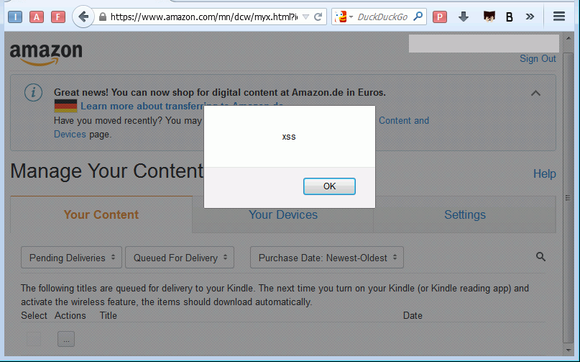 Benjamin Daniel Mussler
Benjamin Daniel Mussler
Getting access to your Amazon account credentials is one of several holy grails for hackers. With access to your Amazon account, hackers can set up new credit cards in your account or max out the current ones on file with some big Amazon purchases. Plus, personal details contained in your Amazon account can lead to the plundering of other online accounts
. It was Concerning then , When security researcher Benjamin Daniel Mussler recently Said That Amazon’s website was vulnerable to a staggeringly simple cross-site scripting attack
The good news, However, Is that Amazon Appears to have fixed the flaw at this writing. Mussler told PCWorld via email That Amazon Appears to have fixed the vulnerability after the security researcher blogged about it on Monday
. We’ve asked Amazon for confirmation of the fix and will update this post shouldering the company responded
. The vulnerability
Imagine this scenario: You find an interesting free e-book online with a filename of “SuperCoolBook.mobi.” Since you want to read it, you download the book and then email it to your Kindle library using the handy Send to Kindle feature
Later That Day, you’re checking out your Kindle library on Amazon’s website when you ‘notice a strange e-book. On closer inspection, you see that the title of the book, as displayed by Amazon, Appears to be computer code zoals
& lt; script src ="https://www.example.org/script.js"& gt; & lt; / script & gt; Whoops! The metadata in Super CoolBook linked to a malicious JavaScript file instead of displaying a clean title. And by visiting Amazon’s site you’ve just enabled That malicious script to run, steal your session cookies, and get access to your Amazon account. Let the looting and lulz beginning
. At least that’s what could’ve happened if the vulnerability still Existed, accor ding to Mussler
. Nate Hoff Elder, who runs the e-book centric blog The Digital Reader, Reported That he was bootable to replicate the weakness as recently as Monday
. Even if this vulnerability was not fixed, However, it would only work under a very specific set of Circumstances. First, you’d have to be a heavy user of the Send to Kindle feature, and you’d need to be downloading e-books and other documents from sketchy places (read: pirate sites)
.
Then you’d have to visit the “Manage Your Content and Devices” page before the script could run. Opening the document in an Amazon app would not be enough. I do not know about you, but prior to running my tests today I could not remember the last time I’d checked my Kindle library content on Amazon.com as Opposed to inside an app.
Nevertheless, it’s a malicious attack Concerning That could happen just by getting tricky with the metadata. Good thing it Appears to be fixed
. This is the second time Muller discovered a scripting vulnerability on Amazon.com. In late 2013, Muller discovered the exact same flaw in Amazon’s site, All which the company fixed three weeks after it was first notified. In July, Muller NOTICED the vulnerability had resurfaced. He Decided to publicize the issue after Amazon did not respond to his second discovery for more than two months.
Thank you for sharing this page.
Sorry! There was an error emailing this page
![]()


No comments:
Post a Comment